When Rainford Junction opened in 1858 the junctions would have been controlled by pointsmen and primitive signals. As the railways became busier such ways of working became inadequate and interlocking signalling systems were introduced.
In 1874 the LYR opened a signal box at Rainford Junction in the fork of the junction between the Liverpool and the St Helens lines. The box was a Saxby and Farmer type 7. It was a three storey brick box with double-height windows. The box was fitted with a 46 lever frame. It controlled the main line through Rainford Junction station and the junctions for the St Helens and the Ormskirk lines. On the St Helens line Rainford Junction box communicated with the Randle Junction LNWR box which was 21 chains distant. On the Ormskirk line Rainford Junction communicated with Bushey Lane Junction LYR box which was 21 chains distant.
 Sometime around 1896 Rainford Junction box was lowered by one storey. It was provided with a new LYR 52 lever frame. That frame was extended at an unknown date to a 56 lever frame. The extra levers were lettered A, B, C and D as they were fitted at the number 1 end. This saved re numbering the whole frame and was standard practice.
Sometime around 1896 Rainford Junction box was lowered by one storey. It was provided with a new LYR 52 lever frame. That frame was extended at an unknown date to a 56 lever frame. The extra levers were lettered A, B, C and D as they were fitted at the number 1 end. This saved re numbering the whole frame and was standard practice.
In January 1922 the LYR merged with the LNWR and a year later on 1 January 1923 the LNWR became part of the London Midland & Scottish Railway (LMS). The LMS altered Rainford Junction signal box in 1933. They replaced the top with an LMS type 11c structure using the original Saxby and Farmer base.
Rainford Junction became part of British Railways London Midland Region on 1 January 1948. The section of line between Rainford Junction and Bushey Lane Junction closed on 6 July 1964 (the section of line between Bushey Lane Junction and White Moss Level crossing having closed on 16 September 1961). The junction was disconnected on 26 September 1964. A small part of the trailing junction was retained as a catch point.
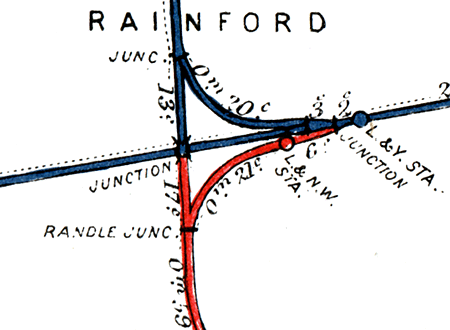 The line to St Helens saw its last traffic on 6 July 1964 but it remained in situ until 22 October 1967 when the junction was disconnected as were the connections to all remaining sidings.
The line to St Helens saw its last traffic on 6 July 1964 but it remained in situ until 22 October 1967 when the junction was disconnected as were the connections to all remaining sidings.
On 10 May 1970 the main crossover was disconnected and the line was singled from Rainford Junction to Fazakerley. Single line working started on Monday 11 May 1970. Second hand signals were used for the singling at Rainford Junction. The number 2 up home signal and the number 9 down main home signal came from Fazakerley West Junction on the former CLC North Liverpool Extension Line. The number 8 down main starting to up and down single line signal came from Knotty Ash also on the CLC line.
In 1976 the down main distant signal was fixed and on 31 January 1984 it was replaced by a reflectorised fixed distant board. The up distant on the single line was replaced by a reflectorised distant board on 30 September 1984.

Rainford Junction signal box seen in its original form sometime before 1896.


 Home
Page
Home
Page
 Sometime around 1896 Rainford Junction box was lowered by one storey. It was provided with a new LYR 52 lever frame. That frame was extended at an unknown date to a 56 lever frame. The extra levers were lettered A, B, C and D as they were fitted at the number 1 end. This saved re numbering the whole frame and was standard practice.
Sometime around 1896 Rainford Junction box was lowered by one storey. It was provided with a new LYR 52 lever frame. That frame was extended at an unknown date to a 56 lever frame. The extra levers were lettered A, B, C and D as they were fitted at the number 1 end. This saved re numbering the whole frame and was standard practice.  The line to St Helens saw its last traffic on 6 July 1964 but it remained in situ until 22 October 1967 when the junction was disconnected as were the connections to all remaining sidings.
The line to St Helens saw its last traffic on 6 July 1964 but it remained in situ until 22 October 1967 when the junction was disconnected as were the connections to all remaining sidings. 
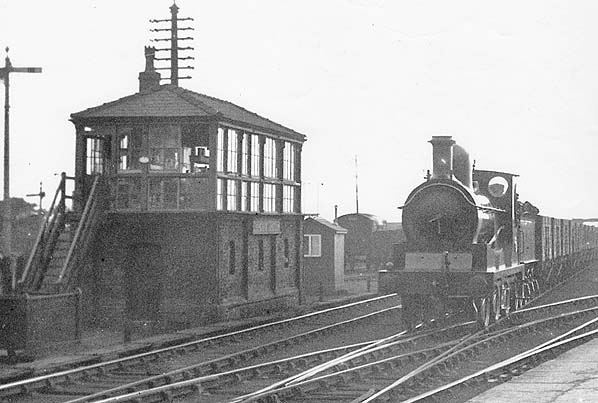 A view looking west in the early years of the 20th century showing Rainford Junction signal box after it had been reduced in height.
A view looking west in the early years of the 20th century showing Rainford Junction signal box after it had been reduced in height.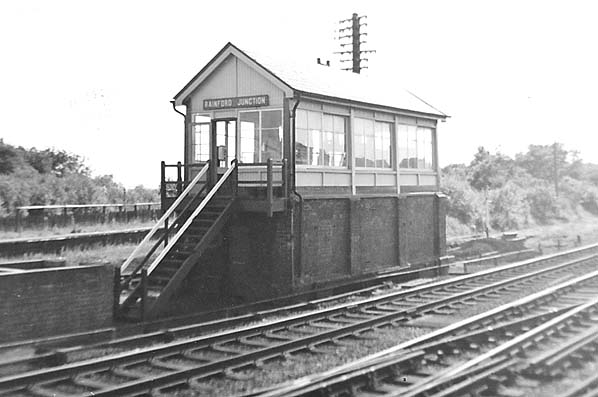 Rainford Junction signal box seen in 1968. The junctions had been disconnected by this time but the line to Fazakerley was still double track.
Rainford Junction signal box seen in 1968. The junctions had been disconnected by this time but the line to Fazakerley was still double track.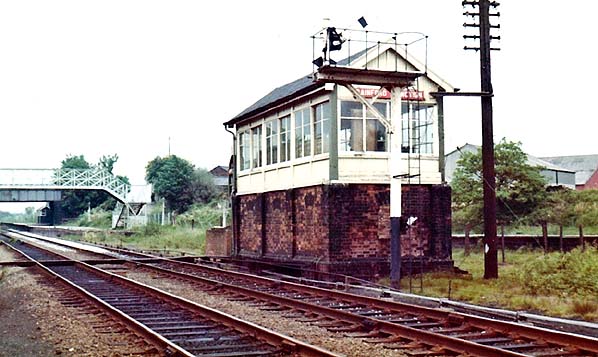
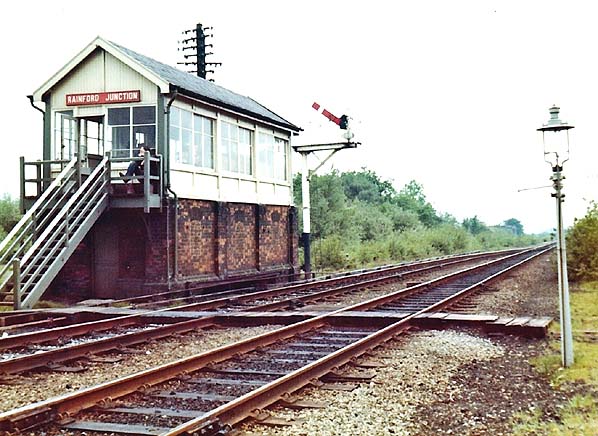
 The Rainford
Junction signal box lever frame seen in 1976.
The Rainford
Junction signal box lever frame seen in 1976..jpg) The interior of Rainford Junction signal box in 1976.
The interior of Rainford Junction signal box in 1976.